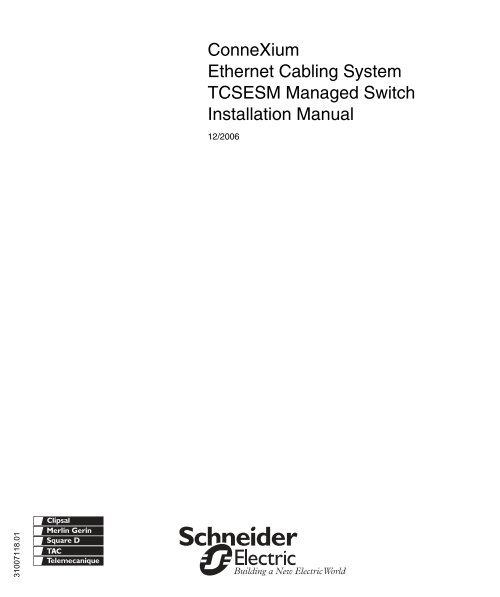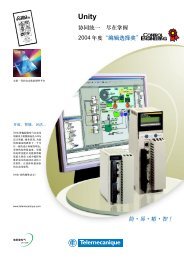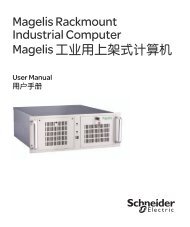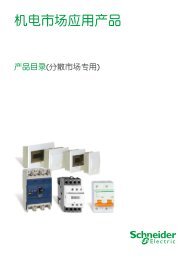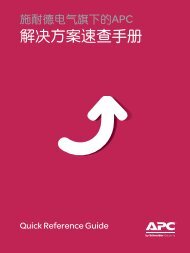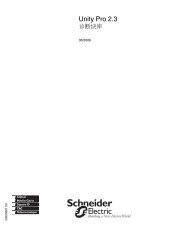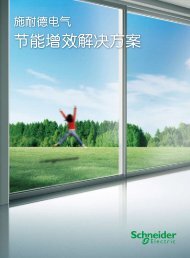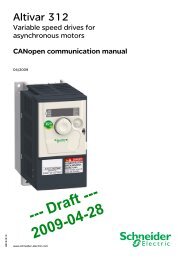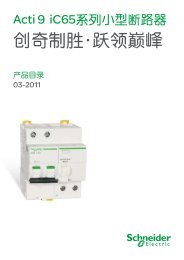ConneXium Ethernet Cabling System TCSESM ... - Schneider Electric
ConneXium Ethernet Cabling System TCSESM ... - Schneider Electric
ConneXium Ethernet Cabling System TCSESM ... - Schneider Electric
You also want an ePaper? Increase the reach of your titles
YUMPU automatically turns print PDFs into web optimized ePapers that Google loves.
<strong>ConneXium</strong><strong>Ethernet</strong> <strong>Cabling</strong> <strong>System</strong><strong>TCSESM</strong> Managed SwitchInstallation Manual12/200631007118.01
Safety InformationNOTICERead these instructions carefully, and look at the equipment to become familiar withthe device before trying to install, operate, or maintain it. The following specialmessages may appear throughout this documentation or on the equipment to warnof potential hazards or to call attention to information that clarifies or simplifies aprocedure.The addition of this symbol to a Danger or Warning safety label indicatesthat an electrical hazard exists, which will result in personal injury if theinstructions are not followed.This is the safety alert symbol. It is used to alert you to potential personalinjury hazards. Obey all safety messages that follow this symbol to avoidpossible injury or death.DANGERDANGER indicates an imminently hazardous situation, which, if not avoided, willresult in death or serious injury.WARNINGWARNING indicates a potentially hazardous situation, which, if not avoided, can resultin death, serious injury, or equipment damage.CAUTIONCAUTION indicates a potentially hazardous situation, which, if not avoided, can resultin injury or equipment damage.PLEASE NOTE<strong>Electric</strong>al equipment should be installed, operated, serviced, and maintained only byqualified personnel. No responsibility is assumed by <strong>Schneider</strong> <strong>Electric</strong> for anyconsequences arising out of the use of this material.© 2006 <strong>Schneider</strong> <strong>Electric</strong>. All Rights Reserved.2 31007118 12/2006
Device Description1At a GlanceOverviewWhat's in thisChapter?This chapter describes the ESM switches and their different versions.This chapter contains the following topics:TopicPageGeneral Switch Description 6The Switch Versions 731007118 12/2006 3
Device DescriptionThe Switch VersionsSwitch VersionsPart Number Part Number Description4 Port Version <strong>TCSESM</strong>043F23F0 4 10/100 TX Managed<strong>TCSESM</strong>043F1CU0 3 10/100 TX 1 100 FX-MM Managed<strong>TCSESM</strong>043F2CU0 2 10/100 TX 2 100 FX-MM Managed<strong>TCSESM</strong>043F1CS0 3 10/100 TX 1 100 FX-SM Managed<strong>TCSESM</strong>043F2CS0 2 10/100 TX 2 100 FX-SM Managed8 Port Version <strong>TCSESM</strong>083F23F0 8 10/100 TX Managed<strong>TCSESM</strong>083F1CU0 7 10/100 TX 1 100 FX-MM Managed<strong>TCSESM</strong>083F2CU0 6 10/100 TX 2 100 FX-MM Managed<strong>TCSESM</strong>083F1CS0 7 10/100 TX 1 100 FX-SM Managed<strong>TCSESM</strong>083F2CS0 6 10/100 TX 2 100 FX-SM Managed<strong>TCSESM</strong>083F2CX0 6 10/100 TX 1 100 FX-MM 1 100 FX-SM Managed16 Port Version <strong>TCSESM</strong>163F23F0 16 10/100 TX Managed<strong>TCSESM</strong>163F2CU0 14 10/100 TX 2 100 FX-MM Managed24 Port Version <strong>TCSESM</strong>243F2CU0 22 10/100 TX 2 100 FX-MM ManagedGigabit - 10 Port <strong>TCSESM</strong>103F23G0 8 10/100 TX 2 10/100/1000 TX ManagedVersion<strong>TCSESM</strong>103F2LG0 8 10/100 TX 2 1000 SFP (fiber) ManagedNote: This product ships with open sockets (SFP)on the fiber ports. In order to use these ports, order1 or 2 fiber modules in any combination (seebelow).Fiber Media TCSEAAF1LFU00 fiber module SFP-SX/LCModules for TCSEAAF1LFS00 fiber module SFP-LX/LCGigabitTCSEAAF1LFH00 fiber module SFP-LH/LCAccessories TCSEAM0100AdapterMemory Back-up Adapter31007118 12/2006 5
Device DescriptionThe figure below shows the 24-port version of the ESM.Port 1 + Port 2, freely selectableMultimode FX, DSC, 100 MbitTelemecaniqueFault+24O O+2417LNK1ACTIP Address3 45 67 89 1011PStandRMON0 1USBV.24FAULRMMAC-Address2345LNKACT1319611517212389<strong>TCSESM</strong>243F2CU0<strong>ConneXium</strong> SwitchThe figure below shows the 10-port (gigabit) versions of the ESM.Port 1 + Port 2TelemecaniqueTwisted pair TX, RJ45, 10/100/1000 MbitFX, SFP-shaft, 1000 MbitLNK1ACTFaultO+24V(P1)PStandRMONO+24VFAULTRM31297IP AddressUSBV.243 4MAC-Address54TelemecaniqueFaultO OV+24V +24PLNK ACTStand byRMON1USBV.24LNK ACTIP AddressFAULTRM3 45 6MAC-AddressLNK2ACT5 67 89 10687 829 10<strong>ConneXium</strong> Switch<strong>TCSESM</strong>103F2LG0<strong>ConneXium</strong> Switch<strong>TCSESM</strong>103F23G08 31007118 12/2006
Installation and Startup2At a GlanceOverviewWhat's in thisChapter?This chapter describes installation and startup of the product.This chapter contains the following topics:TopicPageSafety Instructions 12Configurations 13Installation and Startup 1531007118 12/2006 9
Installation and StartupSafety InstructionsStaffQualificationRequirementsOnly appropriately qualified staff should work on or near this equipment. Such staffmust be thoroughly acquainted with all the warnings and maintenance measurescontained in these operating instructions.The proper and safe operation of thisequipment assumes proper transport, appropriate storage and assembly, andcareful operation and maintenance.Qualified staff according to these operatinginstructions or the warning notes are persons familiar with setting up, assembling,starting up, and operating this product and who have appropriate qualifications tocover their activities, such as:• training or instruction/entitlement to switch circuits and equipment/systems onand off, ground them, and identify them in accordance with current safetystandards,• training or instruction in accordance with current safety standards in looking afterand using appropriate safety equipment,• first aid training.Note: <strong>Electric</strong>ity is used to operate this equipment. Comply in every detail with thesafety requirements specified in the operating instructions regarding the voltagesto apply.Recycling NoteAfter has been put out of use, it must be disposed of properly as electronic waste inaccordance with the effective local, state and national disposal regulations.10 31007118 12/2006
Installation and StartupConfigurationsLine StructureThe ESM switches enable backbones in line structures to be built up. Cascading iscarried out using the backbone ports:Shielded twisted paircord (490NTW000ll)Shielded twisted paircrossed cord (490NTC000ll)<strong>ConneXium</strong>Quantum499NEH10410<strong>ConneXium</strong>499NES25100<strong>ConneXium</strong><strong>TCSESM</strong><strong>ConneXium</strong>499NEH10410Optical fiber or copperline structureRedundant RingStructureWith the redundancy manager function of the ESM modules you can close the twoends of a line structured backbone to a redundant ring, as shown in the figuresbelow. The ESM switches are integrated into the ring via the backbone ports (ports6 and 7). If one section fails the reaction time comes to less than 0.5 s at up to 50ESM modules being cascaded.The following figure describes a redundant ring structure.PremiumQuantum<strong>ConneXium</strong>499NEH10410<strong>ConneXium</strong>499NES25100<strong>ConneXium</strong><strong>TCSESM</strong><strong>ConneXium</strong>499NEH14100Shielded twisted paircord (490NTW000••)Shielded twisted paircord (490NTC000••)Configured redundancy managerredundant ringOptical fiberor copper31007118 12/2006 11
Installation and StartupRedundantCoupling ofNetworkSegmentsThe built-in control intelligence of the ESM allows the redundant coupling of networksegments. The connection of two network segments is realized via two separatepaths. The ESM switches in the redundant line get the redundancy functionassigned by the DIP switch setting standby.The ESM modules in the redundant line and the ESM switches in the main line sharetheir operating states via the control line (crossover <strong>Ethernet</strong> cable).After the failure of the main line the redundant ESM modules enable the redundantline within 0.5 s. If the main line is operational again, the ESM switches in the mainline inform the redundant ESM modules about this. The main line will be enabledand the redundant line will be disabled within 0.5 s.The following figure describes a redundant coupling of optical rings structure:<strong>ConneXium</strong><strong>TCSESM</strong>configured redundancy managerMasterSlavering 1main linecontrol lineredundantcoupling of ring1 and ring 2redundant lineOpticalFiber<strong>ConneXium</strong><strong>TCSESM</strong>Shielded twisted paircrossed cord (490NTC000)<strong>ConneXium</strong>499NOH10510main linecontrol lineredundantcoupling of ring1 and ring 3redundant lineconfigured redundancy managerring 2ring 3Optical FiberOptical Fiber12 31007118 12/2006
Installation and StartupInstallation and StartupOverview ofInstallationWARNINGDUPLICATE ADDRESS HAZARDHaving two or more devices with the same IP address can cause unpredictableoperation of your network. Ensure that you will be assigning a unique IP addressto the switch.Failure to follow this instruction can result in death, serious injury, orequipment damage.On delivery, a switch is always ready for operation.The following installation procedure has been tried and tested in service:• unpacking and checking• filling in the labeling field• adjusting the DIP switch settings• connecting the terminal block for supply voltage and signal contact• fitting the device onto the snap-on rail, grounding• fitting the terminal block, startup• connecting the data linesControlsThe standby and redundancy management functions can be switched on and offwith the two-pin DIP switches on the front panel of the ESM.The default setting is Off for both switches. The standby switch must be on forredundant coupling of 10/100 Mbit/s segments where the ESM is operated inredundant sections in standby mode.The RM (Redundancy Manager) switch must be On to implement this functionalityon the ESM switch. The default settings are as follows: switch position 0 (Off), i.e.,RM function not active.Note: Activate just one of the two functions: standby or RM. Activating bothfunctions simultaneously causes the device to be reset.Two-Pin DIPSwitchThe figure shows the DIP switch.RMONStand by31007118 12/2006 13
Installation and StartupDIP SwitchSettingsThe table shows the DIP switch settings you can make.DIP SwitchesSwitch StateRMSwitchStand-BySwitchRingRedundancyRingCouplingRedundancyManagerRingPortControlPortCouplingPortOFF OFF on off off 1+2ON OFF on off on 1+2OFF ON on on off 1+2 3 4ON ON off off offSupply VoltageWARNINGHAZARD OF ELECTRIC SHOCK OR BURNWhen the module is operated with direct plug-in power units, use only:• SELV supply units that comply with IEC 60950/EN 60950 and• (in USA and Canada) Class 2 power units that comply with applicable nationalor regional electrical codesConnect the ground wire to the PE terminal before you establish any furtherconnections. When you remove connections, disconnect the ground wire last.Failure to follow this instruction can result in death, serious injury, orequipment damage.The supply voltage can be connected redundantly. Both inputs are decoupled.There is no distributed load. With redundant supply, the transformer supplies theESM alone with the higher output voltage. The supply voltage is electrically isolatedfrom the housing.The figure illustrates how to connect the supply voltage on the 6-pin terminal block.FAULTFAULT+24V(P1) OV OV +24V(P2)+24V(P1) OV OV +24V(P2)+ - - +9,6...60 VDC 9,6...60 VDCGG~ ~18...30 VAC 18...30 VAC14 31007118 12/2006
Installation and StartupClass 1, Division2 Wiring NotesNote: Power, input and output (I/O) wiring must be in accordance with Class I,Division 2 wiring methods [Article 501-4(b) of the National <strong>Electric</strong>al Code, NFPA70] and the authority having jurisdiction.Note: Use 60/75 or 75° C copper (CU) wire only.Note: Peripheral equipment must be suitable for the location in which it is used.GroundConnectionThe front panel of <strong>ConneXium</strong> switch modules is grounded via a separate groundconnection. The grounding screw is located on the front panel of the switches. The<strong>Ethernet</strong> RJ-45 socket casings are electrically connected to the front panel of theswitch.Note: Make sure that the electrical installation meets local or nationally applicablesafety regulations.Signal ContactThe signal contact monitors proper functioning of the switch and thus enablesremote diagnostics.The configuration Web pages also allow you to switch the signal contact manuallyand thus to control external devices.If the potential-free signal contact (relay contact, open circuit connection) is opened,the following events are reported:• At least one of the two supply voltages (supply voltage 1 or 2
Installation and StartupInstallationInstall the device as follows:Step Action1 Check whether the DIP switch pre-settings suit your application.2 Unplug the six-pin terminal block and remove it from the switch module and wire upthe supply voltage and indicator lines.3 Fit the switch on a 35 mm standard DIN EN 50 022 rail:4 Attach the upper snap-on slide bar on the module to the DIN rail and press it downuntil it locks in position.5 Connect the ground wire to terminal block.6 Reattach the six-pin terminal block to the switch.7 Turn the power on.8 Install the <strong>Ethernet</strong> cables.8 Start up the switch.Note: Do not open the module housing.Note: The ventilation slits must not be covered, inhibiting free air circulation. The distance tothe ventilation slots of the housing has to be a minimum of 10 cm.Note: This is a Class A device. This equipment may cause radio interference if it is used in aresidential area. It is the operator´s responsibility to take appropriate preventative measures.Note: For use in Class 2 circuits.Note: Use 60/75 or 75 degree C copper (CU) wire only.16 31007118 12/2006
Installation and StartupInterfaces10/100 Mbit/s Twisted Pair Connection10/100 Mbit/s ports (R45 socket) enable the connection of end devices orindependent network segments in compliance with the IEEE 802.3 100BASE-TX/10BASE-T standards. These ports support:• autonegotiation (Speed and Duplex mode)• autocrossing (when autonegotiation is switched on)• autopolarity• 100 Mbit/s half duplex mode, 100 Mbit/s full duplex mode• 10 Mbit/s half duplex mode, 10 Mbit/s full duplex modeThe default setting is as follows: autonegotiation is activated with the exception ofport 1 and 2 (configured by default for Hiper-Ring use): 100 Mbit/s full duplex.The socket housings are galvanically connected to the front panel.The figure below describes the pin assignment of a TP/TX interface.n.c. Pin 8n.c. Pin 7TDn.c.Pin 5Pin 6n.c. Pin 4TD+ Pin 3RD- Pin 2RD+ Pin 110/100/1000 Mbit/s Twisted Pair Connection1000 Mbit/s twisted pair connection 1000 Mbit/s twisted pair ports (R45 sockets)allow you to connect end devices or independent network segments in accordancewith the IEEE 802.3-2000 (ISO/IEC-3:2000 1000BASE-T standard. These portssupport:• autonegotiation (Speed and Duplex mode)• autocrossing (when autonegotiation is switched on)• autopolarity• 1000 Mbit/s full duplex mode• 100 Mbit/s half duplex mode, 100 Mbit/s full duplex mode• 10 Mbit/s half duplex mode, 10 Mbit/s full duplex modeDefault setting: autonegotiationThe socket housings are galvanically connected to the front panel.31007118 12/2006 17
Installation and StartupThe pin assignment corresponds to MDI-X.BI_DC- Pin 8BI_DC+ Pin 7BI_DA- Pin 6BI_DD- Pin 5BI_DD+ Pin 4BI_DA+ Pin 3BI_DB- Pin 2BI_DB+ Pin 1100 Mbit/s F/0 Connection100 Mbit/s F/O ports (SC Duplex) allow you to connect end devices or independentnetwork segments in accordance with the IEEE 802.3 100BASE-FX standard.These ports support full and half duplex mode.Default setting: full duplexNote: Make sure you connect SM ports only to SM ports and MM ports only to MMports.1 Gigabit/s F/0 ConnectionGbit/s F/O ports (SFP sockets and LC fiber modules) enable the connection of enddevices or independent network segments in accordance with the IEEE 802.3-2000(ISO/IEC 8802-3:2000) 1000BASE-SX or 1000BASE-LX standard. These portssupport: autonegotiation and full duplex mode. Default setting: autonegotiationNote: Make sure, that you connect LH ports only to LH ports, SX ports only to SXports and LX ports only to LX ports.18 31007118 12/2006
Installation and StartupLaser LightCAUTIONPOTENTIAL INJURY OR EQUIPMENT DAMAGELED OR LASER components in accordance with IEC 60825-1 (2001):LASER CLASS 1 - CLASS 1 LASER PRODUCTLaser lightDo not look into the beam or view the beam directly with optical instruments(magnifying glasses, microscope).At a distance of less than 100 mm, failure to observe this precaution can causeinjury to your eyes.Light is emitted from the optical connections or from the ends of the connectedoptical fibers that are connected to the optical connections.LIGHT EMITTING DIODE CLASS 2 M, wave length 650 nm, power
Installation and StartupDevice StatusThese LEDs provide information about conditions concerning the operating statusof the entire device.LED Status MeaningP - Powerlit green both supply voltages on(Green/Yellow LEDs) Iit yellow only one supply voltage onnot lit supply voltage is too lowFault - Error it red the signal contact is open, i.e. errornot lit the signal contact is closed, i.e. no errorNote: If the manual adjustment is active on the signal contact,the error display is independent of the signal contact setting.RM - Redundancy Manager lit green RM function active, redundant port not active(Green/Yellow LEDs) lit yellow RM function active, redundant port activenot lit RM function not activeflashesgreenincorrect configuration of HIPER-Ring(e.g. ring not connected to ring port)Stand By lit green stand-by operation activelit yellow stand-by operation not activePort StatusThe green and the yellow LEDs on the individual ports display port-relatedinformation. During booting, those LEDs display the status of the boot procedure.LED Status MeaningLNK (Link Status, Green LED) not lit no valid connectionlit greenvalid connectionflashes green (1 time/s) port is switched to stand byflashes green (3 times/s) port is disabledACT (Data, Yellow LED) not lit no data reception at portflashes yellowdata reception at port20 31007118 12/2006
Installation and StartupMaking BasicSettingsYou must enter IP parameters when the switch is installed for the first time. Theswitch provides five configuration options:• the V.24 interface• the <strong>Ethernet</strong> Switch Configurator software• BOOTP• DHCP• the Memory Back Up Adapter (TCSEAM0100)For detailed information, refer to the chapter Entering the IP Parameters of theConfiguration Manual.Default Settings:• IP address: the device searches the IP address using DHCP.• password for management:• public (write access only, just for the Web-based interface)• private (read and write access)• V.24 data rate: 9,600 baud• ring redundancy: activatedring ports on 100 Mbit full duplex or 1000 Mbit autonegotiation• <strong>Ethernet</strong> ports: The link status is not evaluated.• optical 100 Mbit ports: 100 Mbit full duplexAll other ports: autonegotiation• Redundancy Manager switched off (DIP switch RM: OFF)• stand-by coupling is switched off (DIP switch: stand-by is switched off)port 4 = control port, port 3 = coupling port for redundant ring couplingThe USBInterfaceThe USB socket is an interface which allows you to connect a Memory Back UpAdapter (EAM) locally. The EAM is a device which allows you to save and load theconfiguration and to load the software.Pin NumberSignal Name1 VCC2 - data3 + data4 groundThe V.24Interface(ExternalManagement)RJ11 socket (V.24 interface) is a serial interface which allows you to connect thefollowing devices locally:• an external management station (VT100 terminal or PC with appropriate terminalemulation). (The serial cable that allows external management is part number490NTRJ11.) This allows you to establish a connection to the Command LineInterface and the <strong>System</strong> Monitor.• Memory Back Up Adapter (EAM)31007118 12/2006 21
Installation and StartupSettings VT100 Terminal:Speed:Data:Stopbit:Handshake:Parity:9600 Baud (EMS)8 bit1 bitoffnoneNote: The socket housing is not galvanically insulated from the front panel of theswitch.Note: The V.24 interface is electrically connected to the supply voltage.The figure below describes the pin assignment of the V24 interface.Pin 6Pin 5Pin 8Pin 1Pin 1CTSnot connectedTXGNDRXRTSNote: You can order the terminal cable separately (ref #: 490NTRJ11).RemovalThe following table shows how to remove the switch from the snap-on rail.Step Action1 Move the screwdriver horizontally under the chassis in the locking slide.2 Pull this down — without tilting the screwdriver.3 Pull the switch off the rail.22 31007118 12/2006
Technical DataAAt a GlanceOverviewWhat's in thisChapter?This chapter contains the technical data and the order numbers of the product.This chapter contains the following topics:TopicPageGeneral Technical Hardware Data 26Dimension Drawings 27Electromagnetic Compatibility (EMC) and Physical Resistance 29Network Expansion 30Power Input and Output 31Switches and Accessories 32Underlying Standards 33Agency Approvals 34Certifications 3431007118 12/2006 23
Technical DataGeneral Technical Hardware DataDimensions: W x H x D <strong>TCSESM</strong>04 47 x 131 x 111 mm1.85 x 5.16 x 4.3 in<strong>TCSESM</strong>08 and<strong>TCSESM</strong>10<strong>TCSESM</strong>16 and<strong>TCSESM</strong>2474 x 131 x 111 mm2.91 x 5.16 x 4.37 in111 x 131 x 111 mm4.37 x 5.16 x 4.37 inWeight <strong>TCSESM</strong>04 400 g<strong>TCSESM</strong>08 410 g<strong>TCSESM</strong>10<strong>TCSESM</strong>16 600 g<strong>TCSESM</strong>24 650 gVoltage Supply operating voltage 9.6 to 60 VDC or 18 to 30 VAC safety extra-lowvoltage (SELV), redundant input decoupledRelevant to North America:Nec Class 2 power source 5 A maxOverload Protection at the Inputnon-exchangeable fuseInsulation Voltage between Operating 800 VVoltage and HousingAmbient Conditions operating 0° C (+32° F) to +60° C (+140° F)temperaturestorageambient air: -40° C (-40° F) to +80° C (+176° F)temperaturehumidity10% to 90% (non-condensing)atmosphericpressureup to 2000 m (795 hPa), higher altitudes ondemandPollution Degree 2Protection Classes laser protection Class 1 in accordance with EN 60825-1 (2001)protection class IP 2024 31007118 12/2006
Technical DataDimension Drawings4 and 8 PortVersionsmminch461.830,48111 13,731.24.370.543,60.141315.16742.9130,481.2111 13,734.37 0.543,60.141315.1631007118 12/2006 25
Technical Data16 and 24 PortVersionsmminch1104.3330,481.20110,3 13,734.34 0.543,60.141305.1226 31007118 12/2006
Technical DataElectromagnetic Compatibility (EMC) and Physical ResistanceEMC ImmunityThe product complies with the standards concerning EMC immunity listed below:EMC Immunity Kind of Interference LevelsEN 61000-4-2 discharge of static electricity, contact discharge: test level 3 8 kVEN 61000-4-3 electromagnetic fields, test level 3 (80 -2000 MHz 20 V/mEN 61000-4-4 fast transients (burst), test level 3:• power line 4 kV• data line 4 kVEN 61000-4-5 surge voltages:EN 61000-4-5 • power line: line/line: test level 2 1 kV• power line: line/earth, test level 3 2 kV• data line: test level 3 2 kVEN 61000-4-6 immunity to conducted disturbances induced by radio frequency fields, testlevel 3:• 10 - 150 kHz 3 V• 150 kHz - 80 MHz 10 VEN 61000-4-9 pulse magnetic fields, test level 4 300 A/mEMC InterferenceThe product complies with the standards concerning EMC interference listed below:.EMC InterferenceClassesEN 55022Class AFCC 47 CFR Part 15 Class AGermanischer Lloyd Classification and Building Regulations VI-7-3 Part 1PhysicalResistanceThe product complies with the standards concerning physical resistance listedbelow:.Resistance to Standards concerning ResistanceVibration IEC 60068-2-6, test FC, test levels in accordance with IEC 61131-2Guidelines for the Execution of Prototype Tests, part 1Shock IEC 60068-2-27, Test EA, test level in accordance with IEC 61131-231007118 12/2006 27
Technical DataNetwork ExpansionTP Port100BASE-FXFiber Optic PortA twisted pair cable segment is typically 100 m long (cat5e cable for 1000BASE-TX).The table below lists the network expansion data concerning 100BASE-FX fiberoptic ports.DescriptionWaveLengthFiber<strong>System</strong>AttenuationExpansionFiber DataMultimode FX, DSC, 10/100 Mbit 1300 nm 50/125 μm 0-8 dB 0-5 km 1.0 dB/km, 800 MHz*kmMultimode FX, DSC, 10/100 Mbit 1300 nm 62.5/125 μm 0-11 dB 0-4 km 1.0 dB/km, 500 MHz*kmSingle Mode FX, DSC, 10/100 Mbit 1300 nm 9/125 μm 0-16 dB 0-30 km 0.4 dB/km; 3.5 ps/(nm*km)1000BASE-FXFiber Optic PortThe table below lists the network expansion data concerning 1000BASE-FX fiberoptic ports.DescriptionWaveLengthFiber<strong>System</strong>AttenuationExample of FiberOptic Line LengthFiber DataM-SFP-SX/LC (MM) 850 nm 50/125 μm 0-7.5 dB 0-550 m 3.0 dB/km, 400 MHz*kmM-SFP-LX/LC (MM) 1310 nm (1) 50/125 μm 0-11 dB 0-550 m 1.0 dB/km, 800 MHz*kmM-SFP-SX/LC (MM) 850 nm 62.5/125 μm 0-7.5 dB 0-275 m 3.2 dB/km, 200 MHz*kmM-SFP-LX/LC (MM) 1310 nm (1) 62.5/125 μm 0-11 dB 0-550 m 1.0 dB/km, 500 MHz*kmM-SFP-LX/LC (SM) 1310 nm 9/125 μm 0-11 dB 0-20 km 0.4 dB/km; 3.5 ps/(nm*km)M-SFP-LH/LC (LH) 1550 nm 9/125 μm 6-22 dB 24-72 km 0.25 dB/km; 19 ps/(nm*km)Note: (1) with fiber optic adapter in accordance with IEEE 802.3-2002 clause 38(single-mode fiber offset-launch mode conditioning patch cord)28 31007118 12/2006
Technical DataPower Input and OutputPower Input andOutput ListThe table shows power input and output for the different switch versions.Version Power Input Power Output<strong>TCSESM</strong>04, 2 TX Ports 5.3 W 18.1 Btu (IT)/h<strong>TCSESM</strong>04, 1 FX Port, 1 TX Port 6.5 W 22.2 Btu (IT)/h<strong>TCSESM</strong>04, 2 FX Ports 7.7 W 26.3 Btu (IT)/h<strong>TCSESM</strong>08, 2 TX Ports 5.3 W 18.1 Btu (IT)/h<strong>TCSESM</strong>08, 1 FX Port, 1 TX Port 6.5 W 22.2 Btu (IT)/h<strong>TCSESM</strong>08, 2 FX Ports 7.3 W 26.3 Btu (IT)/h<strong>TCSESM</strong>10 (with Gigabit Ports), 2 TX Ports 8.9 W 30.4 Btu (IT)/h<strong>TCSESM</strong>10 (with Gigabit Ports), 2 FX Ports 8.3 W 28.4 Btu (IT)/h<strong>TCSESM</strong>16, 2 TX Ports 9.4 W 32.1 Btu (IT)/h<strong>TCSESM</strong>16, 2 FX Ports 11.8 W 40.3 Btu (IT)/h<strong>TCSESM</strong>24, 2 FX Ports 15.5 W 52.9 Btu (IT)/h31007118 12/2006 29
Technical DataSwitches and AccessoriesScope ofDeliveryThe delivery comprises:• selected switch version• terminal block for supply voltage and signal contact• description and manuals• CD ROMOrder NumbersPart NumberDescription4 Port Version <strong>TCSESM</strong>043F23F0 4 10/100 TX Managed<strong>TCSESM</strong>043F1CU0 3 10/100 TX 1 100 FX-MM Managed<strong>TCSESM</strong>043F2CU0 2 10/100 TX 2 100 FX-MM Managed<strong>TCSESM</strong>043F1CS0 3 10/100 TX 1 100 FX-SM Managed<strong>TCSESM</strong>043F2CS0 2 10/100 TX 2 100 FX-SM Managed8 Port Version <strong>TCSESM</strong>083F23F0 8 10/100 TX Managed<strong>TCSESM</strong>083F1CU0 7 10/100 TX 1 100 FX-MM Managed<strong>TCSESM</strong>083F2CU0 6 10/100 TX 2 100 FX-MM Managed<strong>TCSESM</strong>083F1CS0 7 10/100 TX 1 100 FX-SM Managed<strong>TCSESM</strong>083F2CS0 6 10/100 TX 2 100 FX-SM Managed<strong>TCSESM</strong>083F2CX0 6 10/100 TX 1 100 FX-MM 1 100 FX-SM Managed16 Port Version <strong>TCSESM</strong>163F23F0 16 10/100 TX Managed<strong>TCSESM</strong>163F2CU0 14 10/100 TX 2 100 FX-MM Managed24 Port Version <strong>TCSESM</strong>243F2CU0 22 10/100 TX 2 100 FX-MM ManagedGigabit - 10 Port <strong>TCSESM</strong>103F23G0 8 10/100 TX 2 10/100/1000 TX ManagedVersion <strong>TCSESM</strong>103F2LG0 8 10/100 TX 2 1000 SFP (fiber) ManagedNote: These products ship with open sockets(SFP) on the fiber ports, so in order to use theseports, you must order 1, or 2, media modulesshown below.Fiber Media TCSEAAF1LFU00 SFP-SX/LC fiber module for GigabitModules TCSEAAF1LFS00 SFP-LX/LC fiber module for GigabitTCSEAAF1LFH00 SFP-LH/LC fiber module for GigabitAccessories TCSEAM0100 Memory Backup Adapter30 31007118 12/2006
Technical DataUnderlying StandardsStandardEN 61000-6-2:2001EN 55022:1998 + A1 2000 + A2-2003EN 60950:2001EN 61131-2:200EN 50121-4:2000FCC 46 CFR Part 15:2003EN 10155EN 61850-3IEEE 1613Contents of StandardGeneric standard: immunity for industrialenvironmentsRadio interference characteristics of informationtechnology equipmentSafety of information technology equipmentProgrammable logic controllersRailroad applications—EMC: interference andimmunity of signal and telecommunicationsequipmentCode of Federal regulationsDeclaration (railroad)Communication networks and systems in stationsStandard environment and testing requirements forcommunication networking devices in electric powersubstations31007118 12/2006 31
Technical DataAgency ApprovalsStandardsUL 508 / CSA C22.2 No. 142Contents of StandardSafety of industrial control equipmentISA 12.12.01 / CSA C22.2 No. 213<strong>Electric</strong>al equipment for use in Class I and Class II,Div. 2 and Class III hazardous (classified) locationsGermanischer Lloyd Classification and construction VI-7-3, part 1,2003 editionCertificationsThe ESM switches have CE certification.32 31007118 12/2006


